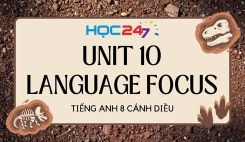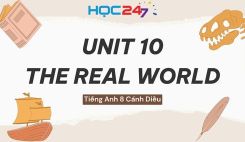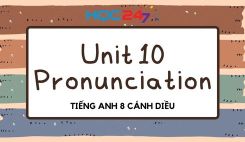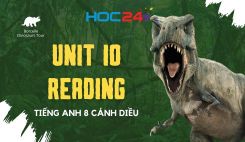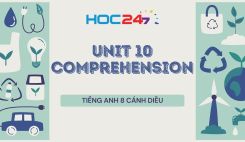Unit 10 TheyŌĆÖve found a fossil Tiß║┐ng Anh 8 C├Īnh diß╗üu ─æŲ░ß╗Żc mß╗¤ ─æß║¦u vß╗øi Lesson Preview vß╗ü chß╗¦ ─æß╗ü kh├Īm ph├Ī, t├¼m hiß╗āu vß╗ü h├│a thß║Īch. B├Āi hß╗Źc sß║Į gi├║p c├Īc em mß╗¤ rß╗Öng vß╗æn tß╗½ v├Ā c├Īc cß║źu tr├║c Tiß║┐ng Anh bß╗Ģ ├Łch. Ch├║c c├Īc em hß╗Źc tß╗æt!
T├│m tß║»t b├Āi
1.1. Unit 10 lß╗øp 8 Preview Task A
Listen to the news. Number the pictures in the order you can hear them (1 - 4).
(Nghe tin tß╗®c. ─É├Īnh sß╗æ c├Īc bß╗®c tranh theo thß╗® tß╗▒ bß║Īn c├│ thß╗ā nghe thß║źy ch├║ng (1 - 4)
Guide to answer
─Éang cß║Łp nhß║Łt file nghe
1.2. Unit 10 lß╗øp 8 Preview Task B
Listen again. Match the places with the statements.
(Lß║»ng nghe mß╗Öt lß║¦n nß╗»a. Gh├®p c├Īc ─æß╗ŗa ─æiß╗ām vß╗øi c├Īc tuy├¬n bß╗æ)
Guide to answer
─Éang cß║Łp nhß║Łt file nghe
1.3. Unit 10 lß╗øp 8 Preview Task C
Work with a partner. Look at the bold words in B. Do you know what are they? Which story in B are you most interested in?
(L├Ām viß╗ćc c├╣ng ─æß╗æi t├Īc. Nh├¼n v├Āo nhß╗»ng tß╗½ in ─æß║Łm trong B. Bß║Īn c├│ biß║┐t ch├║ng l├Ā g├¼ kh├┤ng? C├óu chuyß╗ćn n├Āo trong B bß║Īn t├óm ─æß║»c nhß║źt?)
Guide to answer
Giant dinosaur: The term "giant dinosaur" is a general descriptor that refers to any dinosaur species that were exceptionally large in size, weight, or length.
Early human: Early humans, also known as hominins, are a group of primates that belong to the family Hominidae and include all species that are more closely related to modern humans than to chimpanzees and other great apes. Early humans first appeared around 6-7 million years ago, and over time, they evolved and developed different physical and behavioral characteristics.
Pharaoh: Pharaoh is a term used to refer to the rulers of ancient Egypt who held both political and religious power during the time of the pharaonic civilization.
Huge crocodile: There have been many large crocodile species throughout history, but the one that is commonly regarded as the largest living crocodile species today is the saltwater crocodile (Crocodylus porosus). These reptiles are found in the coastal areas of Southeast Asia and Australia, and can grow up to 23 feet (7 meters) in length and weigh up to 2,200 pounds (1,000 kg).
Tß║Īm dß╗ŗch
Khß╗¦ng long khß╗Ģng lß╗ō: Thuß║Łt ngß╗» "khß╗¦ng long khß╗Ģng lß╗ō" l├Ā mß╗Öt m├┤ tß║Ż chung d├╣ng ─æß╗ā chß╗ē bß║źt kß╗│ lo├Āi khß╗¦ng long n├Āo c├│ k├Łch thŲ░ß╗øc, trß╗Źng lŲ░ß╗Żng hoß║Ęc chiß╗üu d├Āi ─æß║Ęc biß╗ćt lß╗øn.
Con ngŲ░ß╗Øi sŲĪ khai: Con ngŲ░ß╗Øi sŲĪ khai, c├▓n ─æŲ░ß╗Żc gß╗Źi l├Ā vŲ░ß╗Żn nh├ón h├¼nh, l├Ā mß╗Öt nh├│m linh trŲ░ß╗¤ng thuß╗Öc hß╗Ź Hominidae v├Ā bao gß╗ōm tß║źt cß║Ż c├Īc lo├Āi c├│ quan hß╗ć gß║¦n g┼®i vß╗øi con ngŲ░ß╗Øi hiß╗ćn ─æß║Īi hŲĪn l├Ā tinh tinh v├Ā c├Īc lo├Āi vŲ░ß╗Żn lß╗øn kh├Īc. Con ngŲ░ß╗Øi sŲĪ khai xuß║źt hiß╗ćn lß║¦n ─æß║¦u ti├¬n v├Āo khoß║Żng 6-7 triß╗ću n─ām trŲ░ß╗øc v├Ā theo thß╗Øi gian, hß╗Ź tiß║┐n h├│a v├Ā ph├Īt triß╗ān c├Īc ─æß║Ęc ─æiß╗ām thß╗ā chß║źt v├Ā h├Ānh vi kh├Īc nhau.
Pharaoh: Pharaoh l├Ā thuß║Łt ngß╗» d├╣ng ─æß╗ā chß╗ē nhß╗»ng ngŲ░ß╗Øi cai trß╗ŗ Ai Cß║Łp cß╗Ģ ─æß║Īi, nhß╗»ng ngŲ░ß╗Øi nß║»m giß╗» cß║Ż quyß╗ün lß╗▒c ch├Łnh trß╗ŗ v├Ā t├┤n gi├Īo trong thß╗Øi kß╗│ nß╗ün v─ān minh pharaon.
C├Ī sß║źu khß╗Ģng lß╗ō: Trong suß╗æt lß╗ŗch sß╗Ł ─æ├Ż c├│ rß║źt nhiß╗üu lo├Āi c├Ī sß║źu lß╗øn, nhŲ░ng lo├Āi thŲ░ß╗Øng ─æŲ░ß╗Żc coi l├Ā lo├Āi c├Ī sß║źu sß╗æng lß╗øn nhß║źt hiß╗ćn nay ch├Łnh l├Ā c├Ī sß║źu nŲ░ß╗øc mß║Ęn (Crocodylus porosus). Nhß╗»ng lo├Āi b├▓ s├Īt n├Āy ─æŲ░ß╗Żc t├¼m thß║źy ß╗¤ c├Īc khu vß╗▒c ven biß╗ān ─É├┤ng Nam ├ü v├Ā ├Üc, ch├║ng c├│ thß╗ā d├Āi tß╗øi 23 feet (7 m├®t) v├Ā nß║Ęng tß╗øi 2.200 pound (1.000 kg).
B├Āi tß║Łp minh hß╗Źa
Choose the letter A, B, C or D to complete the passage below.
Water pollution happens (1) __________ toxic substances enter water bodies such as lakes, rivers, oceans and so on, getting dissolved in them, lying suspended in the water or depositing on the bed. This degrades the quality of water. Not (2) __________ does this spell disaster for aquatic ecosystems, the pollutants also seep through and reach the groundwater, which might end up in our households as contaminated water we use in our daily activities, including drinking.
Water pollution can be (3) __________ in a number of ways, one of the most polluting being city sewage and industrial waste discharge. Indirect sources (4)__________ water pollution include contaminants that enter the water supply from soils or groundwater systems and from the atmosphere via rain. Soils and groundwater contain (5)__________ residue of human agricultural practices and also improperly disposed of industrial wastes.
Pollutants can be of varying kinds: organic, inorganic, radioactive and so on. In fact, the list of possible water contaminants is just too vast to be listed here.
1. A. what B. when C. why D. while
2. A. both B. only C. well D. either
3. A. cause B. caused C. causing D. causes
4. A. of B. in C. at D. for
5. A. a B. an C. the D. x
Key (─É├Īp ├Īn)
1. B
2. B
3. B
4. A
5. C
Luyß╗ćn tß║Łp
3.1. Kß║┐t luß║Łn
Qua b├Āi hß╗Źc n├Āy c├Īc em sß║Į ghi nhß╗ø tß╗½ vß╗▒ng sau:
- footprint: dß║źu ch├ón
- mummy: x├Īc Ų░ß╗øp
- skeleton: khung xŲ░ŲĪng
- fossil: h├│a thß║Īch
- pharaoh: vua nŲ░ß╗øc Ai Cß║Łp
- crocodile: c├Ī sß║źu
3.2. B├Āi tß║Łp trß║»c nghiß╗ćm Unit 10 - Preview
NhŲ░ vß║Ły l├Ā c├Īc em ─æ├Ż xem qua b├Āi giß║Żng phß║¦n Unit 10 - Preview chŲ░ŲĪng tr├¼nh Tiß║┐ng Anh lß╗øp 8 C├Īnh diß╗üu. ─Éß╗ā cß╗¦ng cß╗æ kiß║┐n thß╗®c b├Āi hß╗Źc mß╗Øi c├Īc em tham gia b├Āi tß║Łp trß║»c nghiß╗ćm Trß║»c nghiß╗ćm Unit 10 lß╗øp 8 C├Īnh diß╗üu Preview ŌĆō ├ön tß║Łp.
C├óu 4-10: Mß╗Øi c├Īc em ─æ─āng nhß║Łp xem tiß║┐p nß╗Öi dung v├Ā thi thß╗Ł Online ─æß╗ā cß╗¦ng cß╗æ kiß║┐n thß╗®c vß╗ü b├Āi hß╗Źc n├Āy nh├®!
Hß╗Åi ─æ├Īp Unit 10 - Preview Tiß║┐ng Anh 8
Trong qu├Ī tr├¼nh hß╗Źc tß║Łp nß║┐u c├│ thß║»c mß║»c hay cß║¦n trß╗Ż gi├║p g├¼ th├¼ c├Īc em h├Ży comment ß╗¤ mß╗źc Hß╗Åi ─æ├Īp, Cß╗Öng ─æß╗ōng Tiß║┐ng Anh HOC247 sß║Į hß╗Ś trß╗Ż cho c├Īc em mß╗Öt c├Īch nhanh ch├│ng!
Ch├║c c├Īc em hß╗Źc tß║Łp tß╗æt v├Ā lu├┤n ─æß║Īt th├Ānh t├Łch cao trong hß╗Źc tß║Łp!
-- Mod Tiß║┐ng Anh 8 Hß╗īC247





.JPG)


